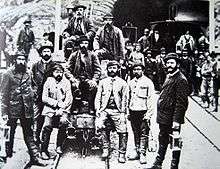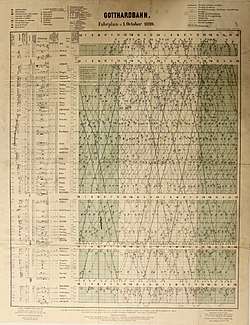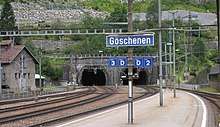Gotthard Tunnel
The Gotthard Tunnel (German: Gotthardtunnel, Italian: Galleria del San Gottardo) is an approximately 15-kilometre-long (9.3 mi) railway tunnel and forms the summit of the Gotthard Railway in Switzerland. It connects Göschenen with Airolo and was the first tunnel through the Saint-Gotthard Massif in order to bypass the St Gotthard Pass. It is built as one double-track, standard gauge tunnel.[2] When opened in 1882, the Gotthard Tunnel was the longest tunnel in the world.
.jpg) Inside the tunnel | |
| Overview | |
|---|---|
| Official name | German: Gotthardtunnel, Italian: Galleria del San Gottardo |
| Line | Gotthard Line |
| Location | Traversing the Saint-Gotthard Massif in the middle of the Swiss Alps |
| Coordinates | 46°35′44″N 8°35′44″E |
| System | Swiss Federal Railways (SBB CFF FFS) |
| Start | Göschenen, canton of Uri (north, 1,106 m (3,629 ft)) |
| End | Airolo, canton of Ticino (south, 1,145 m (3,757 ft)) |
| Operation | |
| Work begun | September 13, 1872 |
| Opened | May 22, 1882 |
| Owner | SBB CFF FFS |
| Operator | SBB Infrastructure |
| Traffic | railway |
| Character | passenger, freight |
| Technical | |
| Design engineer | Louis Favre |
| Length | approx. 15 kilometres (9.3 mi) [1] |
| No. of tracks | Double |
| Track gauge | 1,435 mm (4 ft 8 1⁄2 in) (standard gauge) |
| Electrified | 15 kV 16.7 Hz since October 18, 1920 |
| Highest elevation | 1,151 m (3,776 ft) (inside the tunnel) |
| Lowest elevation | 1,106 m (3,629 ft) (north portal) |
| Tunnel clearance | 7.1 m (23 ft) |
| Width | 8.0 m (26.2 ft) |
| Route map | |
 Route map | |
The tunnel rises from the northern portal at Göschenen (1,106 m (3,629 ft)) and the highest point (1,151 m (3,776 ft)) is reached after approximately 8 kilometres (5.0 mi). After two more kilometers, the border between the cantons of Uri and Ticino is passed; after another 5 kilometres (3.1 mi), the tunnel ends at the southern portal near to Airolo (1,142 m (3,747 ft)). The trip takes about seven to eight minutes by train. Services are operated by the Swiss Federal Railways.
Financing
The Gotthard Railway Company was founded in 1871 under the stewardship of the Swiss industrialist Alfred Escher, who had created the Schweizerische Kreditanstalt in 1856. Despite initial difficulties to finance the project, and resulting costs of about 11% over budget, the financing was shared among private and public investors from Switzerland (20M CHF), Italy (45M CHF) and the German Empire (20M CHF). The bidding war between an engineering company from Geneva and Italy was fought, and finally, the Swiss engineer Louis Favre won the project with an estimated cost of 2830 Swiss francs per meter. Because of his low bid, and the extra costs during construction, Favre increasingly found himself at odds with Swiss politicians and investors alike.[3]
Construction
The tunnel was built from 1871 to 1881 and marked the first large-scale use of dynamite which had been patented in 1867. Construction was supervised by the Swiss engineer Louis Favre, who suffered a fatal heart attack inside the tunnel in 1879. Construction was difficult due to financial, technical and geological issues, the latter of which led to the death of around 200 workers (the exact number is not known) mainly due to water inrushes; many were also killed by the compressed air-driven trains carrying excavated material out of the tunnel. There were also serious health issues caused by an epidemic of hookworm infection (Ancylostoma duodenale).[4][5][6] Medical investigations led to "major advances in parasitology, by way of research into the aetiology, epidemiology and treatment of ancylostomiasis".[5] A strike of the workers in 1875 was crushed by the Swiss Army, killing four and wounding 13.
A memorial for the dead workers was erected in 1932 near the station building at Airolo. The memorial contains a relief by Vincenzo Vela from 1882/1883, titled "Vittime del lavoro" (Victims of labour).
 Workers in Airolo (1880) |
 Pneumatic locomotive with attached pressure container.[7] |
 Memorial for the dead workers with a relief by Vincenzo Vela |
Operation

The tunnel was opened for traffic in 1882, operated by the private railway company Gotthardbahn, which ran from Lucerne to Chiasso at the Italian border. The Gotthardbahn was integrated into the Swiss Federal Railways in 1909. In 1920, the first electric trains were run through the Gotthard Tunnel. Initially the voltage had to be reduced from the desired 15 kilovolts to 7.5 kV, because the grime deposited on the insulators by the steam locomotives encouraged excessive arcing. However, in May the next year, steam was replaced entirely by electric traction, and the problem of soot and grime was eliminated.[8]
Until the opening of the Gotthard Road Tunnel in 1980, the Swiss Federal Railways offered piggyback services for cars and trucks through the Gotthard Tunnel. Today, that service exists as the rolling highway from the German to the Italian border and aims to reduce truck traffic on Swiss expressways. An improvisational piggyback service from Göschenen to Airolo was offered during the two-month closure of the Gotthard Road Tunnel in 2001.
 Entry to the Gotthard Tunnel at Göschenen |
 Entry to the Gotthard Tunnel at Airolo |
Neighbouring tunnels
The adjacent ramps include several turn tunnels (see Table of turn tunnels). The nearby Gotthard Road Tunnel was opened in 1980. A second railway tunnel, the Gotthard Base Tunnel, much longer and at a lower elevation than the Gotthard Tunnel, opened on 1 June 2016.[9]
See also
- Saint-Gotthard Massif
- St Gotthard Pass
- Gotthard Base Tunnel
- Gotthard Road Tunnel
- NRLA
References
| Wikimedia Commons has media related to Gotthard rail tunnel. |
- Length was first published by the operators of the tunnel, Gotthardbahn, in 1882 when the tunnel opened. It was stated as "... tunnellänge ist ungefähr 3 1⁄8 meile." (en: ... tunnel length is approximately 3 1/8 miles). The length of the meile in use in that part of Switzerland (approx. 4800 metres) means that the length converts to 15 kilometres. But as the original measurement is approximate, so is the conversion.
- Eisenbahnatlas Schweiz. Verlag Schweers + Wall GmbH. 2012. p. 34. ISBN 978-3-89494-130-7.
- Tebart A (2013). Tunnelblick: 150 Jahre St. Gotthard Ingenieur.de (Technikgeschichte). Retrieved January 19, 2015.
- E. Bugnion, "On the epidemic caused by Ankylostomum among the workmen in the St. Gothard Tunnel", British Medical Journal, volume 1, page 382, 1881.
- R. Peduzzi and J.-C. Piffaretti, "Ancylostoma duodenale and the Saint Gothard anaemia", British Medical Journal, volume 287, pages 1942–1945, 1983.
- Bibliography of Hookworm Disease
- Braun, Adolphe: Photographische Ansichten der Gotthardbahn, Dornach im Elsass, ca. 1875
- Book: "Die Bahn durch den Gotthard"
- BBC News - Swiss Gotthard rail tunnel - an engineering triumph
Further reading
- Gautier, Adolphe (April 22, 1880). "The St. Gothard Tunnel". Nature (Editorial). 21 (547): 581–6. doi:10.1038/021581a0.
| Records | ||
|---|---|---|
| Preceded by Fréjus Rail Tunnel |
Longest tunnel 1882–1906 |
Succeeded by Simplon Tunnel |